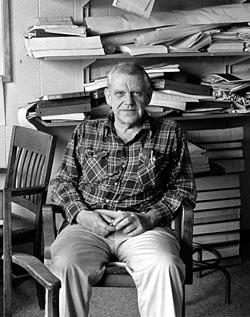Henry Stommel facts for kids
Quick facts for kids
Henry Stommel
|
|
|---|---|

Henry Stommel
|
|
| Born | September 27, 1920 |
| Died | January 17, 1992 (aged 71) |
| Alma mater | Yale University |
| Known for | ocean circulation Gulf Stream |
| Awards | ForMemRS Bigelow Medal (1974) Maurice Ewing Medal (1977) Alexander Agassiz Medal (1979) William Bowie Medal (1982) Crafoord Prize (1983) National Medal of Science (1989) |
| Scientific career | |
| Fields | physical oceanography |
| Institutions | Yale University MIT |
Henry Melson Stommel (born September 27, 1920 – died January 17, 1992) was a very important scientist. He studied the ocean, especially how its currents move. Starting in the 1940s, he developed ideas about how ocean currents flow around the world. He also studied the Gulf Stream, a powerful ocean current. His work is still a key part of how we understand the ocean today. Many people saw Stommel as one of the most important oceanographers of his time. He was great at both creating new theories and observing the ocean from ships.
Early Life and Learning
Henry Stommel was born in Wilmington, Delaware. He was a bit unusual for a modern scientist. He became a full professor at a university without earning a doctorate degree. He got his first degree in astronomy from Yale University in 1942. After that, he taught math and astronomy at Yale from 1942 to 1944.
Working at Universities
From 1944 to 1959, Stommel worked at the Woods Hole Oceanographic Institution. The Office of Naval Research helped fund his projects there. In 1959, he became a professor of oceanography at Harvard University. Then, in 1963, he moved to the MIT. He stayed at MIT until 1978, when he went back to Woods Hole. He worked there until he retired.
Stommel also started a special ocean station called PANULIRUS in Bermuda in 1954. PANULIRUS was also the name of a research ship. Every month, this ship collected seawater samples from the surface down to very deep parts of the ocean. Scientists measured the temperature, saltiness, and other chemicals in these samples. Because the ocean floor drops very steeply near Bermuda, they could get good samples close to land. The information collected at PANULIRUS is the longest set of ocean data like this in the North Atlantic Ocean.
Stommel was chosen to be part of the National Academy of Sciences in 1962. He also received the National Medal of Science in 1989. This is one of the highest awards a scientist can get in the United States.
Amazing Ocean Discoveries
Henry Stommel showed why strong ocean currents, like the Gulf Stream, are found on the western sides of ocean basins. This happens because of something called the "beta effect." It's related to the Coriolis effect, which is a force that affects moving objects on Earth. This force changes depending on how far north or south you are.
Because of this "beta effect," currents on the western side of oceans, like the Gulf Stream and the Kuroshio Current, are much stronger and more steady. Currents on the eastern side, like the California Current, are usually weaker. These strong western currents are important for moving warm water from the tropics towards the colder poles.
Stommel also worked with Arnold Arons to understand deep ocean currents. They suggested that surface water sinks in cold polar regions. This water then flows along the western sides of ocean basins in deep currents. This idea was based on lab studies and was proven true later. It was a huge success for ocean science. Stommel also created early models of the thermohaline circulation. This is a global ocean current system driven by differences in temperature and saltiness. He suggested it might have more than one stable way of flowing.
Besides his work on large ocean currents, Stommel studied many other ocean and weather topics. For example, he helped classify different types of estuaries (where rivers meet the sea). He also looked at how volcanoes might affect Earth's climate.
Family Life
Henry Stommel married Elizabeth Brown on December 6, 1950. Elizabeth's father, Huntington Brown, was an English professor at the University of Minnesota. Henry and Elizabeth had three children. Their son Matthew became a professional fisherman. Their son Elijah became a doctor. Their daughter Abigail became a nurse.

